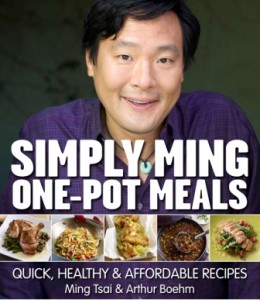
This is Part 1 of my review series on Simply Ming One-Pot Meals: Quick, Healthy & Affordable Recipes, which covers a basic read-through, difficulty level of recipes, familiarity of ingredients, and overall production quality.
I will start cooking from the book in Part 2. If I don’t do a Part 2, that means I don’t really use the book, which should give you an idea on its functionality. Eventually, I’ll post The Verdict, letting you know my overall opinion of things.
There won’t always be pictures, for sometimes hands are just too messy for cameras.
Details
Type: Hardcover with dust jacket
Length: 192 pages
Size: 10.1″ x 9″
Published: November 2010
Publisher: Kyle Books
Full Retail Price: $29.95
Amazon Price: $19.77 (as of Dec 2010)
Author
I hate to say it, but I’d never even heard of Ming Tsai until a Macy’s PR woman emailed me to invite me to his demonstration at Macy’s Ala Moana here in Honolulu last month. I looked him up and thought he was interesting enough, having been the host of his own cooking shows and being a current contestant on Season 3 of The Next Iron Chef. I was lucky enough to get my copy signed.
Host of his own cooking show called Simply Ming, this is the second of his “Simply Ming” cookbooks.
First Glance
The book begins with a brief introduction, which is a bit odd in that where it usually has the author’s signature or name, it’s missing. I wonder if that was intentional or just overlooked. Anyway, the recipes are separated into chapters of cooking methods including Braise, Wok, Saute, Roast, High Temp, Soup, and Toss.
Each recipe features one full page photograph to show you the final dish, which is great because I hate it when cookbooks have recipes without photos. The instructions seem minimal on some pages, with only 2-4 steps, but upon closer inspection the many steps of cooking are simply condensed into fewer steps. Each recipe comes with a suggested wine, which does me no good since I don’t drink wine and the most I can do is tell you which ones are red and which ones are white.
Some of the recipes contain a “Ming’s Tip”, which is a little extra tip to help you with the cooking. I like this feature, as it seems to tackle some thing that you don’t think about when cooking, but once a mistake happens, you wish you knew more about it.
Ingredients
While many of the recipes are indeed “simple and affordable”, this book is of a higher class than I usually care for, asking for some ingredients that I’ve never heard of or have no idea how to obtain. For instance, I have no idea where I can get pasteurized liquid egg yolks. I don’t know what sambal or togarashi chiles are. Ming includes them in his ingredients chapter in the front, but I’d have to go to a specialty Asian market to find them.
A lot of his listed ingredients seem too fancy-pants for me. Organic Worcestershire sauce? Vegetarian oyster sauce? Grapeseed oil? Parmigiano-Reggiano cheese? Ancho chili powder? I have no idea if these ingredients are “affordable” but it doesn’t sound like it.
Thankfully, these ingredients aren’t used very often, but it’s still a discouraging thing for a simple cook like myself. I’m still anxious to try some of the recipes, such as the Flash-Fried Eggplant or Potato-Crusted Halibut, as both look and sound really good.
Overall Quality
The book has beautiful food photography and a nice layout with a good font for reading. I say food photography because the photographs of Ming himself leave something to be desired. At the start of the book there’s a photo of him holding up a dish and he looks sweaty and uncomfortable, standing slanted and holding his dish at an awkward angle. His front cover photo is downright creepy, so much so that my husband requested that I take the book off the table because he couldn’t stand the sight of him. If you remove the dust jacket, the book cover is a nice, simple black with a thick, heavy font. It looks much better without it.
The book seems well organized, though I wish it had a more thorough Table of Contents. It simply lists the cooking method chapters I mentioned earlier. If you want to see a list of recipes, you have to sift through the Glossary in the back.
Each recipe features a personal story from Ming about why he included the dish and sometimes a bit of history of the food itself. It’s a nice way to get to know a little more about his culinary background.
Conclusion
Although the book touts healthy recipes, quite a few of the recipes seem to be very heavy meat and starch. While these are probably comforting and delicious, I wouldn’t really call them healthy. Still, there are some recipes that do sound very healthy, such as the New-Style Halibut Sashimi Soup. This sounds deliciously light and healthy to me and I wish the book stuck to recipes along this line.
At the full price of $29.95, I don’t think this book is worth it if you’re an everyday home cook just looking for something to pull together for your family dinner. If you’re a fan of Ming and like to get a little fancier, I’m sure you’ll find the book a nice, fun way to be a part of his culinary talents. For myself, there are only a small handful of recipes (3-4) I’d realistically try, making the $20.00 I spent on the book not really worth it for me. Still, I’ll have to hang on to mine because it’s signed to Pikko.
Browse Ming Tsai’s cookbooks on Amazon:

1 thought on “Review: Simply Ming One Pot Meals, Part 1”